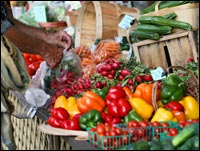The local-food movement has reached an interesting juncture.
Through one lens, things are looking better than ever. According to a USDA report (PDF), the number of farmers’ markets leapt 79 percent to 3,100 between 1994 and 2002. Community-supported agriculture programs — wherein consumers buy a share of a farm’s output before the season starts, sharing the risks and rewards of the harvest — have followed a similar trajectory. According to one source, North America boasts 1,200 CSAs. Just 25 years ago, the concept didn’t exist in these parts.

Tastes great, less shipping.
Photo: iStockphoto
All that growth aside, though, the overall market for local produce remains tiny. The USDA reckons that farmers’ markets account for less than 2 percent of the more than $70 billion Americans spend on produce. And, as I’ve pointed out before, the overall income picture for small commercial farms is dismal. Key USDA stat: Farms with annual revenues between $10,000 and $99,000 — which describes the vast majority of farmers’ market vendors — have an average operating profit margin of negative 24.5 percent.
Simply put, small farms lose money, and their losses are financed by the off-farm incomes of the families that run them. From this angle, so-called sustainable farming looks like a precarious enterprise.
Why, then, do farmers’ markets and CSAs continue to grow and multiply? Why do people still farm? The local-food revival, it seems to me, runs on passion: people’s desire for connection to the seasons, to the soil that feeds them, to powerful flavors that can’t be manufactured with chemicals or preserved over 1,300-mile delivery hauls. Aside from the dot-com bubble of the 1990s, I can think of no great boom in American history built more on enthusiasm, and less on profit.
Yet passion has practical limits (as investors in, say, Pets.com learned in 2000). For local farms to supply significantly more than 2 percent of the nation’s produce (or meat, dairy, and eggs, for that matter), small-scale farming will have to become an economically viable activity.
Some optimists argue that market forces are already quietly working to achieve that goal. The argument goes like this: surging consumer demand for local food — coupled with rising energy costs — has convinced the large supermarket companies to rethink their far-flung supply chains and seek out small-scale producers near individual retail outlets. These corporate buyers will pump cash into local farm economies across the nation, reviving the fortunes of small-scale farmers.
Certainly, evidence for this scenario abounds. The phrase “local is the new organic” has become commonplace. Having turned organic food into another consumer fetish drained of much of its original meaning, the big corporate retailers are setting their sights on “local” cache. Shoppers entering Whole Foods outlets can hardly grab a basket without reading “buy local” propaganda. One pamphlet that confronted me on a recent visit poses the question, “What is local?” The answer seems a bit lenient to me: produce labeled “local” must “travel no more than … seven hours from the farm to our facility.”
Still, Whole Foods has committed resources to local foodsheds. After a scrape with industrial-agriculture critic Michael Pollan, CEO John Mackey pledged $10 million per year in loans to small-scale farmers, among other initiatives.
Wal-Mart, too, claims to have found “buy local” religion, at least with regard to food. The Bentonville behemoth clawed its way to the top of the world’s retail heap by undercutting local commerce near its ever-multiplying outlets. Now Wal-Mart execs are talking as earnestly as food co-op managers about minimizing “food miles” and supporting nearby farmers. Amanda Griscom Little, attending a Wal-Mart corporate retreat last month, reported in Grist that the company planned to move “away from selling monoculture produce at all stores to more diversity in produce based on region (instead of Yukon potatoes at every store, dozens of different potato varieties at different stores depending on what’s local).”
Sincere though these efforts may be, however, I doubt whether they’ll amount to much. The problem facing local food production isn’t lack of demand; it’s lack of infrastructure. To boost production to a level that might please the likes of Wal-Mart or Whole Foods, a given area’s small-scale farms need access to capital — to invest in farm equipment, composting capacity, washing and cooling facilities, and delivery trucks.
In the area where I farm, western North Carolina’s High Country, every small-scale farm operation I know of, including my own, encounters bottlenecks every day caused by infrastructural gaps. If a corporate buyer appeared with a big order, it’s hard to imagine how our area’s farmers, or the buyer, would walk away happy.
Since small farms generally lose money, they can hardly be counted on to make those investments themselves, and few banks are eager to invest in businesses with negative operating margins. Nor can corporations, bound by law to maximize shareholder profit, be expected to fund the rebuilding of local foodsheds — Whole Foods’ pledge of $10 million per year aside.
Yet the situation need not be so bleak. The farmers who supply the nation’s farmers’ markets and CSAs, despite brutal economics, represent a huge asset. Communities, and the nation as a whole, should figure out ways to collectively leverage the passion of these growers. Not through direct payments — as with the current $14.5 billion per year subsidy boondoggle — but rather through strategic investments in food-production infrastructure.
As for individuals, the way forward is clear: seek out farmers’ markets, CSAs, and restaurants that procure locally. And stifle your sticker shock. That two-dollar tomato will likely deliver an experience that can’t be bought at any price at a supermarket. The cheap-food regime under which we feed ourselves, a topic I’ll return to in this column, is really a costly scam.


